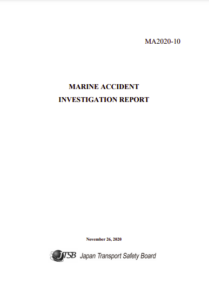JTSB issued an investigation report on the collision of the oil/chemical tanker EOS with the cargo ship AISHO No.8, in the Nagoya Port North Passage, Aichi Prefecture, in March 2019. The investigation stressed that each master respectively attempted to avoid the incident, but course signals made using international signal flags were not checked and VHF communication was not maintained.
The incident
As the oil tanker and chemical tanker EOS was proceeding southwest and the cargo ship AISHO No. 8 was proceeding north, both vessels collided in the Nagoya Port North Passage. EOS sustained a breach and other damage to its port bow plating shell and AISHO No. 8 sustained dents and other damage to her bow bulwark.
Probable causes
Probably, as Vessel A was proceeding southwest toward the North Passage, Master A observed Vessel B off of the bow and assumed that the two ships were in a meeting relationship and would pass port-to-port. He also considered that Vessel B would cross the North Passage on an easterly course and head in the direction that Vessel A had come, and therefore he continued navigating at the same course and speed.
Meanwhile, Master B assumed that Vessel B, which was navigating within the North Passage, was in a position of maintaining course and Vessel A, which was about to enter the North Passage, would give way to Vessel B, and therefore he turned to port and proceeded north.
The JTSB report found probable that each master respectively attempted to avoid an accident:
- Firstly, Master A set the rudder hard to starboard and stopped the main engine with the intention of avoiding a collision by passing port-to-port because Vessel B had come too close.
- Secondly, Master B saw Vessel A’s bow approaching off the bow and make a sudden turn to starboard, sensed the danger of collision, and set the main engine to full astern.
It is probable that the fact that course signals made using international signal flags were not checked and communication by VHF or other means was not made between Vessel A and Vessel B contributed to the accident,
…the report reads.
Actions taken
-Company A implemented the following measures following the accident:
- Issued the following instructions to all of its vessels:
- Maintain safe speeds and safe distances based on conventions, laws, and ordinances.
- Never hesitate to use the engine in an emergency situation.
- Never decide maneuvering of other vessels in advance as a personal presumption.
- Decided to revise its company QSMS procedure and add the stationing of a navigation officer on the bridge when entering and leaving port.
- Decided to shorten intervals between BRTM-related training and practice sessions.
- Decided to conduct unannounced safety management monitoring and supervision visits of its vessels.
-On its part, company B implemented the following measures:
- Decided to station one conning officer and at least one person on watch and radar on the bridge when entering or leaving port and navigating within a port, and specifically mentioned this in operational standards.
- Had crew members of its vessels recheck procedures for avoiding hazards, including engaging in radio communication by VHF or other means and issuing warnings with acoustic signals at an early stage.
- Decided to provide periodic crew education concerning understanding of applicable laws and ordinances using this accident and past accidents, with particular focus on important sections of the Act on Port Regulations, etc.
Recommendations
The JTSB suggested the following actions maybe useful in preventing the reoccurrence of a similar accident:
- When there is uncertainty about another vessel’s movements, bridge watchkeepers mutually confirm ship maneuvering intentions with course signals using international signal flags for vessel encounters and actively and appropriately arouse the other vessel’s attention by VHF communication or acoustic signals, rather than make decisions based on assumptions of the other vessel’s movements.
- Bridge watchkeepers accurately comprehend and follow navigation rules established in the Act on Port Regulations, etc.
Explore more herebelow:































































